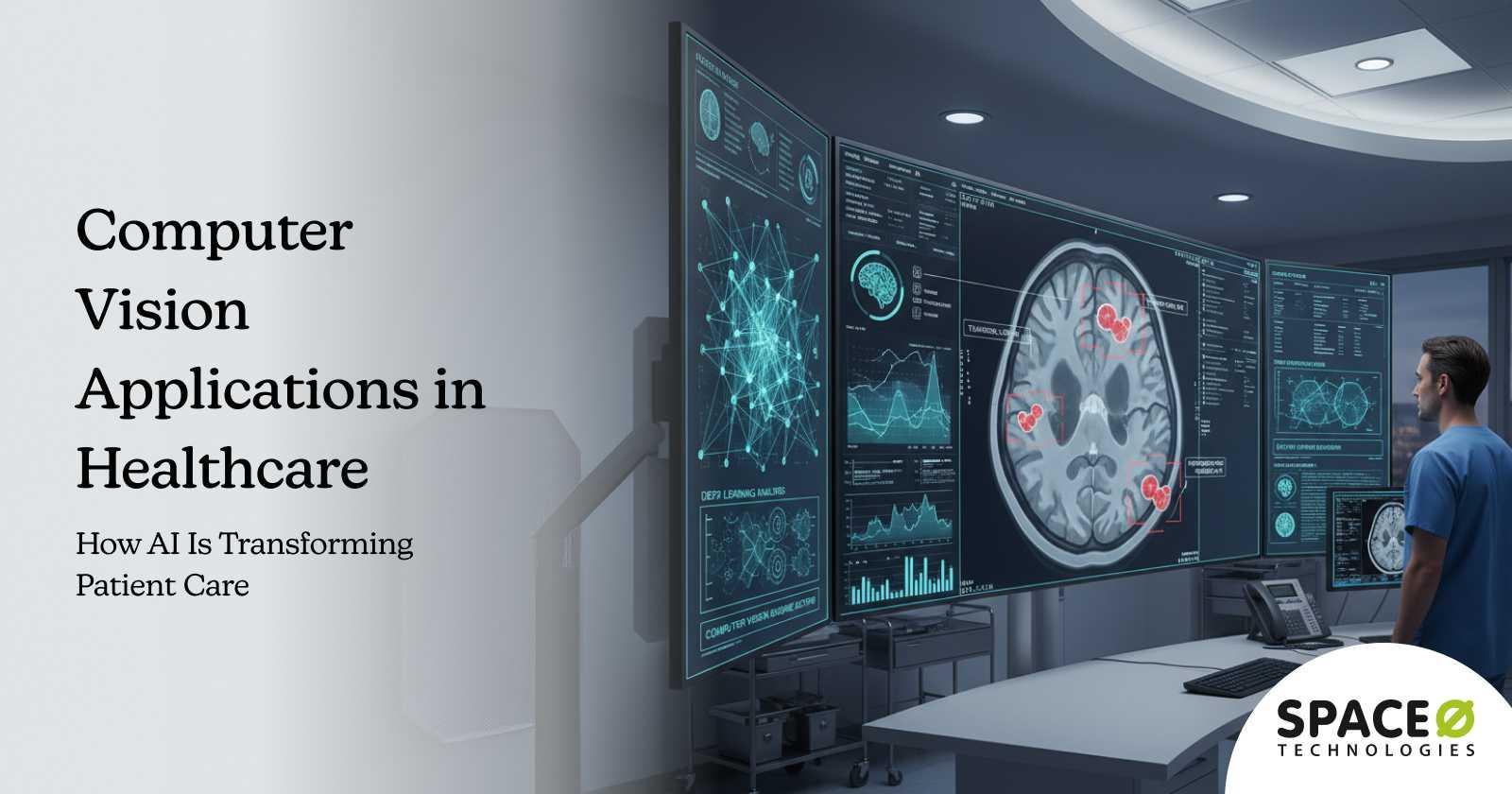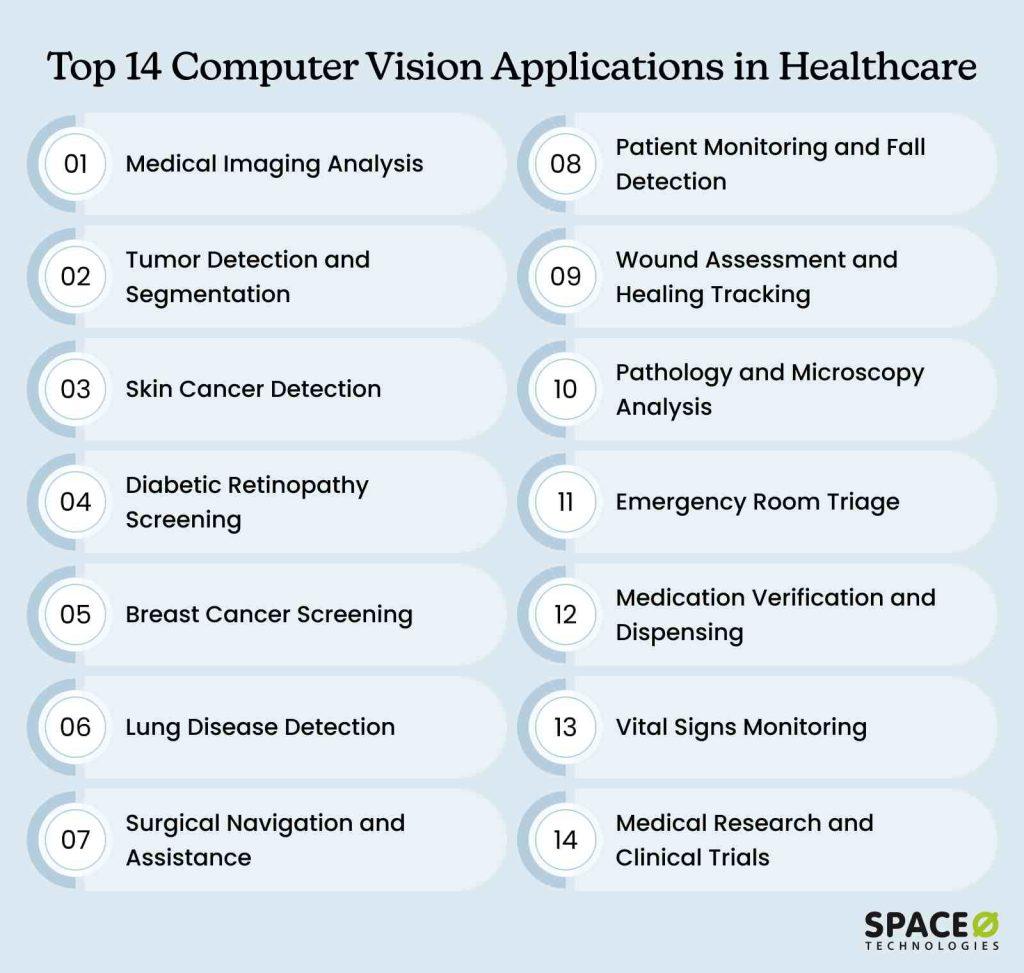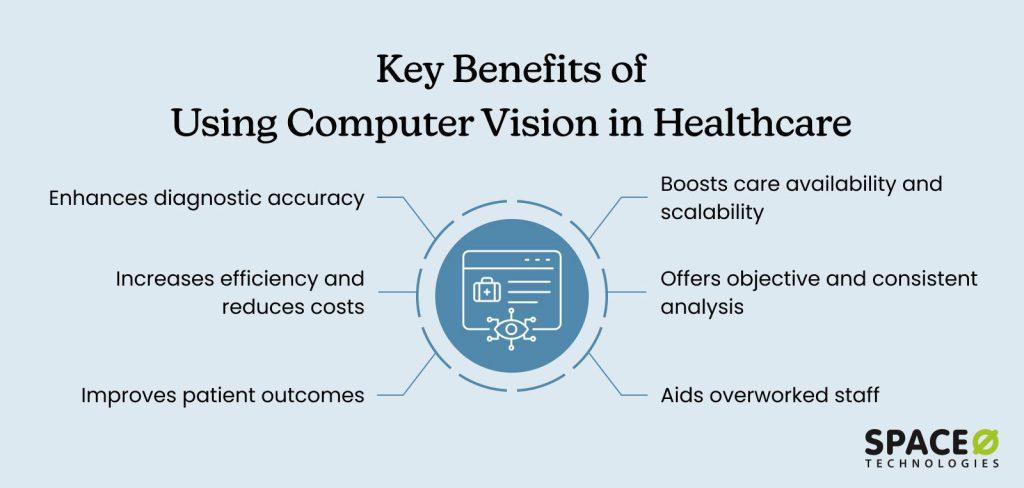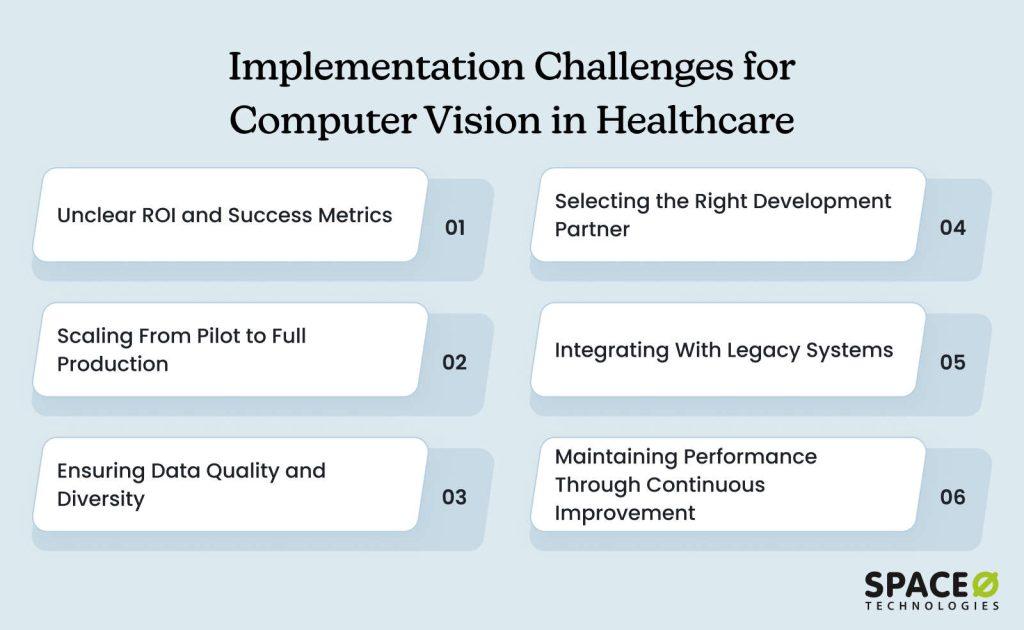
Have you ever wondered how AI can detect diseases faster than the human eye? Or how hospitals are using technology to monitor patients in real time and make surgeries more precise? The answer lies in computer vision, a cutting-edge technology that is transforming healthcare as we know it.
According to GrandViewResearch, the computer vision in healthcare market is expected to reach USD 15,600.8 million by 2030, reflecting the growing adoption of AI-powered imaging, diagnostics, and patient monitoring solutions. From analyzing medical scans to enabling real-time patient tracking, computer vision is helping healthcare providers deliver faster, more accurate, and safer care.
This blog dives into 14 key applications of computer vision in healthcare. As a leading computer vision development company, we have also covered our insights into the benefits and potential implementation challenges for seamless adoption. Let’s get started.

These applications of computer vision span five major categories: diagnostic imaging, patient monitoring, surgical assistance, hospital operations, and medical research. Each solves specific healthcare challenges while improving efficiency and outcomes.
Let’s explore the 14 most impactful computer vision application examples transforming healthcare today.
Radiologists must review thousands of scans each week, often under intense time pressure. The repetitive nature of image interpretation leads to fatigue and declining focus, increasing the risk of missed abnormalities and diagnostic delays. As workloads grow, maintaining accuracy becomes harder, contributing to rising burnout across radiology departments.
| Real Impact: Patients get answers faster, doctors avoid burnout, and hospitals serve more people without compromising quality. |
Oncologists need precise tumor boundaries to plan radiation therapy and surgical interventions, and manual segmentation is time-consuming, subject to inter-observer variability, and requires expert knowledge. Even millimeter-level errors in tumor mapping can result in healthy tissue damage or incomplete cancer treatment, directly affecting patient survival rates and quality of life.
| Real Impact: Even small measurement errors can mean the difference between effective treatment and serious complications. |
Build Your Healthcare Computer Vision Solution With Experts
Work with Space-O AI’s experienced team to develop healthcare AI solutions that save time, reduce errors, and deliver results you can trustDermatologists must identify dangerous melanomas among many benign lesions, a task that demands years of expertise and sharp visual judgment. Limited access to specialists, especially in rural areas, often delays diagnosis. Moreover, as early melanomas show few clear signs, even skilled clinicians can miss cancers or order unnecessary biopsies.
| Real Impact: Catches warning signs early when treatment is most effective, potentially saving lives through early detection. |
Diabetes gradually damages retinal blood vessels without noticeable symptoms until vision loss becomes permanent. Regular screening can prevent blindness, but a shortage of ophthalmologists and time-intensive manual exams leaves many patients unscreened, blocking access to simple, sight-saving care.
| Real Impact: Prevents blindness in diabetics through early detection when simple treatments still work. |
Mammography screening demands that radiologists review hundreds of images each day with sustained focus to catch subtle abnormalities. As fatigue sets in, accuracy declines, leading to missed cancers or unnecessary biopsies. Heavy workloads and limited capacity often create long wait times for results, delaying critical treatment.
| Real Impact: Earlier detection means less aggressive treatment and better survival rates. |
Chest X-rays and CT scans reveal complex patterns linked to pneumonia, tuberculosis, lung cancer, and COVID-19. Radiologists must distinguish between these conditions that often appear similar, all while handling heavy case volumes.
Tiny nodules signaling early-stage lung cancer can easily blend into surrounding tissue, making accurate detection extremely challenging even for experienced specialists.
| Real Impact: Early detection of lung diseases significantly improves treatment outcomes and survival rates. |
Surgeons operate in intricate 3D environments where vital nerves and vessels remain hidden beneath tissue. Achieving millimeter-level precision is critical, yet traditional surgery depends on interpreting 2D images and mental visualization. Limited visibility, anatomical variation, and natural hand tremor increase the risk of nerve damage, excessive bleeding, or procedural failure.
| Real Impact: Safer surgeries with better outcomes and faster patient recovery. |
Falls are a leading cause of injury and hospitalization among elderly patients, especially during understaffed nighttime hours. Conventional monitoring depends on intrusive wearables that patients often remove, and manual rounds that disrupt rest. At the same time, without constant observation, staff may miss critical moments, delaying response and worsening injuries.
| Real Impact: Fewer fall-related injuries mean shorter hospital stays, lower costs, and better patient outcomes. |
Transform Patient Care with Proven AI Expertise
Our team builds computer vision applications that improve diagnostics, enhance monitoring, and streamline hospital operationsChronic wounds affect millions of patients with diabetes, vascular disease, and mobility limitations. Different caregivers measure wounds inconsistently, creating documentation that obscures healing trends or deterioration.
This lack of objective tracking makes it difficult for clinicians to determine treatment effectiveness, often leading them to continue ineffective approaches while wounds worsen and infection risks increase significantly.
| Real Impact: Better wound management reduces complications, amputations, and healthcare costs while improving patient quality of life. |
Pathologists examine thousands of cells under a microscope to detect and grade tumors that determine treatment decisions. The process demands hours of intense focus and absolute precision, but human fatigue and subjective judgment introduce variability. Shortages of skilled professionals further delay diagnoses, directly affecting patient outcomes.
| Real Impact: Faster, more accurate diagnoses lead to quicker treatment decisions and better patient outcomes. |
Overcrowded emergency departments demand split-second assessments that determine treatment priority. Nurses must evaluate dozens of patients per hour under intense pressure, often with limited information. Subtle signs of life-threatening conditions can be missed, while overtriaging mild cases strains already limited resources.
| Real Impact: More accurate triage means critical patients get treatment faster while system capacity is optimized. For more accurate results, hire experienced computer vision developers to build custom triage solutions that integrate seamlessly with existing emergency systems and deliver superior accuracy. |
Medication errors cause thousands of preventable deaths annually despite multiple safety checkpoints. Pills look remarkably similar across drugs, while hospital pharmacies process hundreds of orders daily under intense time pressure. This creates opportunities for wrong medication, dose, or patient errors.
Even a single mistake can prove fatal, yet manual verification relies on human vigilance that’s vulnerable to fatigue and distraction.
| Real Impact: Fewer medication errors mean safer patients and reduced liability for healthcare facilities. |
Traditional vital sign monitoring requires contact-based devices that limit mobility and increase infection risks. And, often, equipment shortages or gaps between manual checks leave patients unobserved for long periods. This leads to caretakers missing early signs of deterioration, which sometimes makes the patient’s condition critical.
| Real Impact: Earlier detection of patient deterioration enables life-saving interventions and reduces ICU transfers. |
Medical research requires analyzing thousands of images to identify patterns and validate new therapies. Manual analysis creates bottlenecks lasting months or years, delaying life-saving discoveries.
Human measurement variability introduces bias that compromises research validity, while small teams lack resources for the massive datasets needed. This creates a painful clash between publication timelines and the reality of thorough analysis.
| Real Impact: Faster research means new treatments reach patients sooner, advancing medical science and improving care. |
Having explored these 14 powerful applications, let’s examine the concrete benefits driving healthcare organizations to invest in computer vision technology. Partnering with specialized computer vision development companies can help healthcare providers implement these applications while ensuring compliance with medical regulations and data privacy standards.
Looking for an Experienced Computer Vision Development Partner?
With 15+ years of computer vision development experience, we offer tailored healthcare AI solutions. Let Space-O AI build custom computer vision solutions that give your hospital smarter tools and faster insights
Healthcare organizations implementing computer vision realize substantial improvements across clinical and operational metrics. From reduced diagnostic errors and faster throughput to lower costs and better patient satisfaction, the technology delivers measurable ROI that justifies the initial investment. Let’s take a look at the top benefits:
Computer vision systems analyze medical images with consistency that humans can’t match. They detect subtle patterns indicating disease in early stages when treatment is most effective. Studies show AI-assisted diagnosis reduces errors and catches abnormalities that radiologists miss. This improved accuracy translates directly into better clinical outcomes and cost savings.
Beyond accuracy gains, automation handles routine analysis tasks, freeing medical professionals for complex cases requiring expertise. Hospitals process more patients without proportional staff increases. Faster diagnoses mean shorter hospital stays and reduced costs throughout the healthcare system. These efficiency improvements create capacity for treating more patients.
The combination of accuracy and efficiency drives measurable patient benefits. Earlier disease detection, more accurate diagnoses, and better surgical precision directly improve patient outcomes. Fewer complications mean faster recovery, better quality of life, and reduced mortality rates across various conditions. Patients experience care that’s both faster and more effective.
Unlike human staff, computer vision systems work continuously without fatigue, providing consistent analysis day and night. This technology scales easily to handle volume spikes without additional staffing costs. Rural facilities gain access to specialist-level analysis without geographic constraints. Round-the-clock availability ensures patients receive timely care regardless of when they arrive.
Continuous operation also enables standardization across all cases. AI eliminates variability between different human evaluators. Every analysis follows the same criteria without influence from fatigue, stress, or subjective interpretation. This consistency improves quality and supports better clinical research. Healthcare organizations benefit from reproducible results they can trust.
Finally, these systems address the human cost of healthcare delivery. Healthcare professionals face increasing workloads and burnout. Computer vision handles time-consuming screening and analysis tasks, allowing clinicians to focus on patient interaction and complex decision-making. This support improves job satisfaction and retention while ensuring clinicians work at the top of their expertise.
While the benefits are compelling, successful implementation requires addressing several important challenges head-on. Many healthcare organizations opt for computer vision consulting services to navigate these complexities with experts and avoid costly missteps. Let’s look at a few of these challenges.

Strategic implementation requires addressing key challenges with proven solutions to ensure computer vision delivers expected benefits and ROI. From data quality and system integration to staff adoption and regulatory compliance, each challenge demands careful planning and execution to avoid common pitfalls.
Organizations struggle to justify investment without measurable objectives or baseline data, making it impossible to demonstrate value or secure continued funding when stakeholders demand concrete evidence.
Identify specific problems computer vision solves with quantifiable impact and establish baseline measurements for accuracy, efficiency, and cost before implementation. Define concrete success metrics, including diagnostic accuracy improvements, time savings per case, cost reductions, and patient outcome enhancements to prove future value.
Pilot projects succeeding in controlled environments often fail at scale when unforeseen technical issues, workflow disruptions, and infrastructure limitations emerge during production deployment.
Start with a focused pilot in a controlled environment, testing across multiple departments and patient populations. Collect user feedback and refine based on real-world experience. During the pilot, evaluate server capacity, data storage requirements, processing speeds, and integration points to understand full-scale infrastructure needs.
Finally, build a deployment roadmap that phases expansion based on pilot learnings to identify potential issues before significant investment.
AI systems require thousands of diverse, accurately labeled images representing actual patient populations. Many organizations lack sufficient data volume, face labeling inconsistencies, or have datasets skewed toward specific demographics, producing unreliable results during real-world deployment.
Invest significant time in data preparation with diverse, accurately labeled examples. Partner with clinical experts for accurate annotation while ensuring datasets represent your actual patient population across age, gender, ethnicity, and conditions. Audit existing data for quality and completeness, remembering your AI is only as good as the data it learns from.
Many technology vendors lack healthcare-specific expertise, leading to systems that fail regulatory requirements, don’t integrate with existing workflows, or miss critical clinical nuances that prevent successful implementation.
Select an AI development company like Space-O AI, with proven computer vision development expertise in the healthcare domain. Review detailed case studies from similar healthcare projects while verifying HIPAA compliance experience and FDA regulatory pathway understanding. Evaluate their team’s clinical domain knowledge to ensure they understand both technology and healthcare delivery realities.
Healthcare organizations operate complex IT ecosystems with legacy EHR platforms, PACS systems, and clinical workflows that weren’t designed for AI integration, requiring seamless connections without disrupting existing operations or demanding complete infrastructure overhauls.
Work with IT teams from the project beginning, ensuring compatibility with existing systems. Map data flows, API integrations, and user interfaces carefully while planning for middleware where direct connections aren’t feasible. Involve medical professionals throughout development and test integrations thoroughly in staging environments to prevent costly rework.
AI models degrade over time as clinical practices evolve, new equipment is introduced, imaging protocols change, or patient populations shift. Static systems become outdated, producing unreliable results that erode clinical trust while requiring ongoing resources and expertise.
Implement feedback mechanisms where clinicians flag incorrect predictions or edge cases. Establish regular performance monitoring to track accuracy, processing time, and user satisfaction. Use collected feedback for continuous model improvement while scheduling regular retraining with new data.
Not Sure How to Start with AI in Healthcare?
Partner with Space-O AI to ideate, develop, and implement reliable, high-performing healthcare computer vision solutions that deliver measurable resultsComputer vision is transforming healthcare by making diagnostics faster and more precise, improving patient monitoring, supporting surgical procedures, and streamlining hospital operations. AI-powered imaging, real-time analysis, and predictive insights are helping healthcare providers deliver better outcomes while reducing costs and operational inefficiencies.
At Space-O AI, we specialize in end-to-end computer vision development for healthcare. Our capabilities include:
With 15+ years of AI experience and 500+ successful projects, Space-O AI is your trusted partner for building innovative, reliable, and impactful computer vision solutions in healthcare.
Ready to transform your healthcare operations with AI? Connect with our experts today for a consultation and explore tailored computer vision solutions that meet your unique needs.
Computer vision systems typically achieve 90-95% accuracy in many diagnostic tasks, often matching or exceeding human expert performance. Accuracy depends on the specific application, training data quality, and model architecture. FDA-approved systems for diabetic retinopathy detection demonstrate accuracy comparable to specialist ophthalmologists in clinical trials.
Implementation costs vary significantly by scope. Pilot projects typically cost $50,000–$150,000, while comprehensive hospital-wide systems can exceed $1 million. Costs include software development, hardware infrastructure, data preparation, integration, and training. Most organizations see positive ROI within 2-3 years.
No. Computer vision augments medical professionals rather than replacing them. The technology handles routine screening and analysis, allowing doctors to focus on complex cases requiring human judgment and empathy. Final diagnostic decisions remain with qualified medical professionals.
Implementation timelines range from 3-12 months, depending on project scope and organizational readiness. Focused pilot projects might launch in 3-6 months. Enterprise-wide deployments typically require 9-12 months, depending on data availability, integration complexity, and regulatory requirements.
Healthcare computer vision systems implement multiple security layers, including end-to-end encryption, strict access controls, and HIPAA-compliant infrastructure. Many solutions use on-device processing to avoid sending sensitive data to cloud servers. Anonymization techniques remove identifying information from training data.
Let’s Bring Your Healthcare AI Idea to Life
What to read next